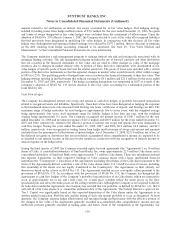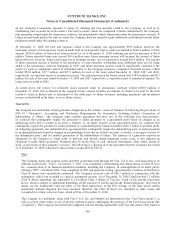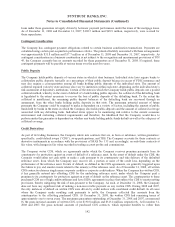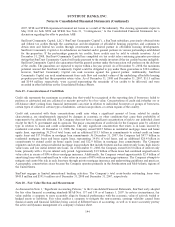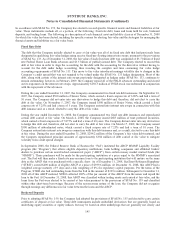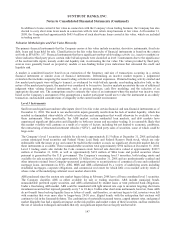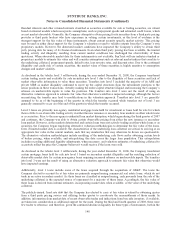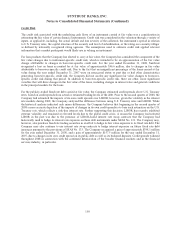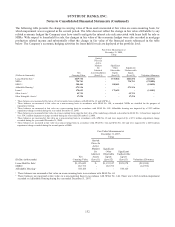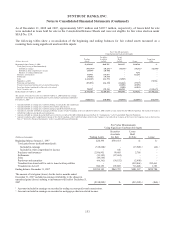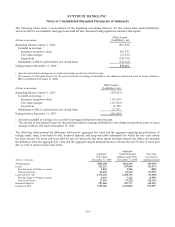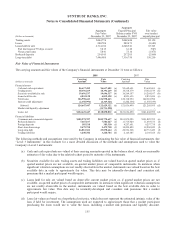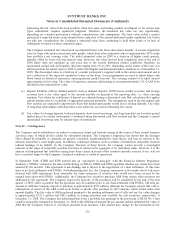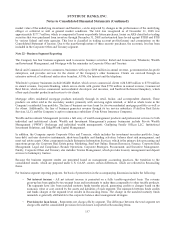SunTrust 2008 Annual Report Download - page 159
Download and view the complete annual report
Please find page 159 of the 2008 SunTrust annual report below. You can navigate through the pages in the report by either clicking on the pages listed below, or by using the keyword search tool below to find specific information within the annual report.
SUNTRUST BANKS, INC.
Notes to Consolidated Financial Statements (Continued)
In addition to loans carried at fair value in connection with the Company’s loan trading business, the Company has also
elected to carry short-term loans made in connection with its total return swap business at fair value. At December 31,
2008, the Company had approximately $603.4 million of such short-term loans carried at fair value, which are included
in trading assets.
Valuation Methodologies and Fair Value Hierarchy
The primary financial instruments that the Company carries at fair value include securities, derivative instruments, fixed rate
debt, loans and loans held for sale. Classification in the fair value hierarchy of financial instruments is based on the criteria
set forth in SFAS No. 157. Financial instruments that have significant unobservable trading activity (i.e., inactive markets) or
where indicative third party prices contain wide bid/ask spreads were classified as level 3 instruments due to the significance
of the unobservable inputs, namely credit and liquidity risk, in estimating the fair value. The values provided by third party
sources were generally based on proprietary models or non-binding broker price indications that estimated the credit and
liquidity risk.
A market is considered inactive based on an evaluation of the frequency and size of transactions occurring in a certain
financial instrument or similar class of financial instruments. Determining an inactive market requires a judgmental
evaluation that includes comparing the recent trading activities to historical experience. If limited trading activity existed and
few market participants were willing to transact, as evidenced by wide bid/ask spreads, non-binding indicative bids, or the
nature of the market participants, the market was considered to be inactive. Inactive markets necessitate the use of additional
judgment when valuing financial instruments, such as pricing matrices, cash flow modeling, and the selection of an
appropriate discount rate. The assumptions used to estimate the value of an instrument where the market was inactive were
based on the Company’s assessment of the assumptions a market participant would use to value the instrument in an orderly
transaction, and included considerations of illiquidity in the current market environment.
Level 3 Instruments
SunTrust used significant unobservable inputs (level 3) to fair value certain financial and non-financial instruments as of
December 31, 2008. The need to use unobservable inputs generally results from the lack of market liquidity, which has
resulted in diminished observability of both actual trades and assumptions that would otherwise be available to value
these instruments. More specifically, the ABS market, certain residential loan markets, and debt markets have
experienced significant dislocation and illiquidity in both new issues and secondary trading. It is reasonably likely that
this market volatility will continue as a result of a variety of factors, including but not limited to economic conditions,
the restructuring of structured investment vehicles (“SIVs”), and third party sales of securities, some of which could be
large-scale.
The Company’s level 3 securities available for sale totals approximately $1.5 billion at December 31, 2008 and include
certain municipal bond securities and Federal Home Loan Bank and Federal Reserve Bank stock, which are only
redeemable with the issuer at par and cannot be traded in the market; as such, no significant observable market data for
these instruments is available. These nonmarketable securities total approximately $934 million at December 31, 2008.
Level 3 trading assets also include the Coke common stock forward sale derivative valued at approximately $249.5
million at December 31, 2008, as well as approximately $674 million of SBA loans and pooled securities whose
payment is guaranteed by the U.S. government. The Company’s remaining level 3 securities, both trading assets and
available for sale securities, totals approximately $1 billion at December 31, 2008 and are predominantly residual and
other interests retained from Company-sponsored participations or securitizations of commercial loans and residential
mortgage loans, investments in SIVs, ARS, MBS and ABS collateralized by a variety of underlying assets including
residential mortgages, corporate obligations, and commercial real estate for which little or no market activity exists or
whose value of the underlying collateral is not market observable.
ARS purchased since the auction rate market began failing in February 2008 have all been considered level 3 securities.
The Company classifies ARS as either available for sale or trading securities. ARS include municipal bonds,
nonmarketable preferred equity securities, and ABS collateralized by student loans or trust preferred bank obligations.
Under a functioning ARS market, ARS could be remarketed with tight interest rate caps to investors targeting short-term
investment securities that repriced generally every 7 to 28 days. Unlike other short-term instruments, however, these ARS
do not benefit from back-up liquidity lines or letters of credit, and therefore, as auctions began to fail, investors were left
with securities that were more akin to longer-term, 20-30 year, illiquid bonds, with the anticipation that auctions will
continue to fail in the foreseeable future. The combination of materially increased tenors, capped interest rates, and general
market illiquidity has had a significant impact on the risk profiles and market values of these securities, and has resulted in
the use of valuation techniques and models that rely on significant inputs that are largely unobservable.
147



